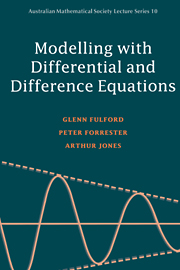Book contents
- Frontmatter
- Contents
- Preface
- Introduction to the student
- Part One Simple Models in Mechanics
- Part Two Models with Difference Equations
- 7 Difference equations
- 8 Linear difference equations in finance and economics
- 9 Non-linear difference equations and population growth
- 10 Models for population genetics
- Part Three Models with Differential Equations
- Part Four Further Mechanics
- Part Five Coupled Models
- References
- Index
10 - Models for population genetics
Published online by Cambridge University Press: 05 June 2012
- Frontmatter
- Contents
- Preface
- Introduction to the student
- Part One Simple Models in Mechanics
- Part Two Models with Difference Equations
- 7 Difference equations
- 8 Linear difference equations in finance and economics
- 9 Non-linear difference equations and population growth
- 10 Models for population genetics
- Part Three Models with Differential Equations
- Part Four Further Mechanics
- Part Five Coupled Models
- References
- Index
Summary
In the previous chapter, difference equations were used to predict the change in the total population of a species from generation to generation. This leads naturally to the question of predicting the change in a particular characteristic of the individuals in the population. Since the heredity units which determine characteristics are the genes, this question comes under the heading of population genetics.
The formulation of models in population genetics requires a knowledge of the fundamentals of the theory of genetics. This chapter begins by presenting the required theory, before formulating particular models in terms of difference equations. These models differ from those obtained in the previous two chapters in that they are based on some firmly established laws. In this respect they are similar to the models obtained in mechanics. The laws of genetics, however, are expressed as probabilities and hence are only relevant, in practice, to populations which are sufficiently large.
The models in population genetics give rise to non-linear difference equations. This chapter assumes the elements of probability theory.
Some background genetics
An ability to predict the most probable characteristics of offspring from knowledge of the characteristics of the parents is a skill of prime importance to plant and animal breeders as well as to medical scientists. In many cases this problem can be reduced to the study of difference equations – but only after the fundamentals of the theory of genetics have been learned. This section presents the necessary background theory.
- Type
- Chapter
- Information
- Modelling with Differential and Difference Equations , pp. 177 - 200Publisher: Cambridge University PressPrint publication year: 1997

